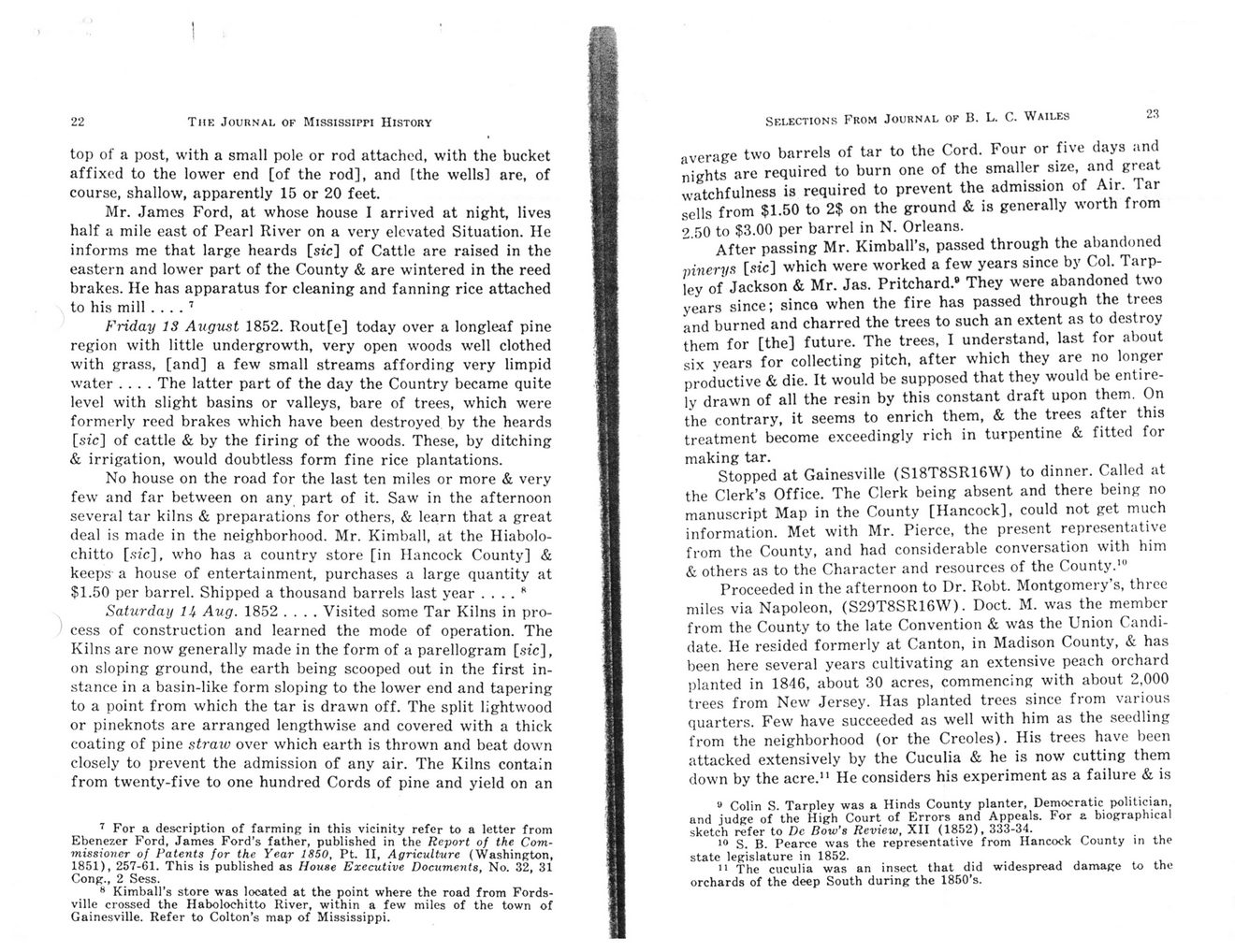This text was obtained via automated optical character recognition.
It has not been edited and may therefore contain several errors.
22 The Journal of Mississippi History top of a post, with a small pole or rod attached, with the bucket affixed to the lower end [of the rod], and [the wells] are, of course, shallow, apparently 15 or 20 feet. Mr. James Ford, at whose house I arrived at night, lives half a mile east of Pearl River on a very elevated Situation. He informs me that large heards [sic] of Cattle are raised in the eastern and lower part of the County & are wintered in the reed brakes. He has apparatus for cleaning and fanning rice attached to his mill .... 7 Friday IS August 1852. Rout[e] today over a longleaf pine region with little undergrowth, very open woods well clothed with grass, [and] a few small streams affording very limpid water .... The latter part of the day the Country became quite level with slight basins or valleys, bare of trees, which were formerly reed brakes which have been destroyed by the heards [sic] of cattle & by the firing of the woods. These, by ditching & irrigation, would doubtless form fine rice plantations. No house on the road for the last ten miles or more & very few and far between on any part of it. Saw in the afternoon several tar kilns & preparations for others, & learn that a great deal is made in the neighborhood. Mr. Kimball, at the Hiabolo-chitto [sic], who has a country store [in Hancock County] & keeps a house of entertainment, purchases a large quantity at $1.50 per barrel. Shipped a thousand barrels last year .... 8 Saturday IU Aug. 1852 .... Visited some Tar Kilns in pro-) cess of construction and learned the mode of operation. The Kilns are now generally made in the form of a parellogram [sic], on sloping ground, the earth being scooped out in the first instance in a basin-like form sloping to the lower end and tapering to a point from which the tar is drawn off. The split lightwood or pineknots are arranged lengthwise and covered with a thick coating of pine straiv over which earth is thrown and beat down closely to prevent the admission of any air. The Kilns contain from twenty-five to one hundred Cords of pine and yield on an 7 For a description of farming in this vicinity refer to a letter from Ebenezer Ford, James Ford’s father, published in the Report of the Commissioner of Patents for the Year 1850, Pt. II, Agriculture (Washington, 1851), 257-61. This is published as House Executive Documents, No. 32, 31 Cong., 2 Sess. s Kimball's store was located at the point where the road from Fords-ville crossed the Habolochitto River, within a few miles of the town of Gainesville. Refer to Colton’s map of Mississippi. Sf.lections From Journal of B. L. C. Wailes 23 average two barrels of tar to the Cord. Four or five days and nights are required to burn one of the smaller size, and great watchfulness is required to prevent the admission of Air. Tar sells from $1.50 to 2$ on the ground & is generally worth from 2.50 to $3.00 per barrel in N. Orleans. After passing Mr. Kimball’s, passed through the abandoned pinerys [sic] which were worked a few years since by Col. Tarp-ley of Jackson & Mr. Jas. Pritchard.8 They were abandoned two years since; sinco when the fire has passed through the trees and burned and charred the trees to such an extent as to destroy them for [the] future. The trees, I understand, last for about six years for collecting pitch, after which they are no longer productive & die. It would be supposed that they would be entirely drawn of all the resin by this constant draft upon them. On the contrary, it seems to enrich them, & the trees after this treatment become exceedingly rich in turpentine & fitted for making tar. Stopped at Gainesville (S18T8SR16W) to dinner. Called at the Clerk’s Office. The Clerk being absent and there being no manuscript Map in the County [Hancock], could not get much information. Met with Mr. Pierce, the present representative from the County, and had considerable conversation with him & others as to the Character and resources of the County.10 Proceeded in the afternoon to Dr. Robt. Montgomery’s, three miles via Napoleon, (S29T8SR16W). Doct. M. was the member from the County to the late Convention & was the Union Candidate. He resided formerly at Canton, in Madison County, & has been here several years cultivating an extensive peach orchard planted in 1846, about 30 acres, commencing with about 2,000 trees from New Jersey. Has planted trees since from various quarters. Few have succeeded as well with him as the seedling from the neighborhood (or the Creoles). His trees have been attacked extensively by the Cuculia & he is now cutting them down by the acre.11 He considers his experiment as a failure & is u Colin S. Tarpley was a Hinds County planter, Democratic politician, and judge of the High Court of Errors and Appeals. For a biographical sketch refer to Dc Bow’s Review, XII (1852), 333-34. 10 S. B. Pearce was the representative from Hancock County in the state legislature in 1852. 11 The cuculia was an insect that did widespread damage to the orchards of the deep South during the 1850’s.

Gainesville Benjamin-Wailes-1852-3